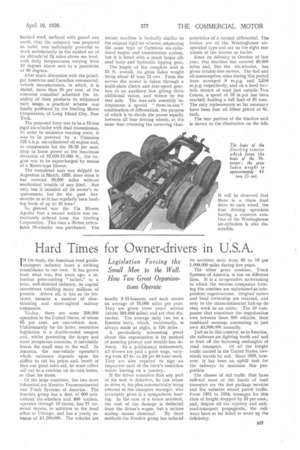Hard Times for Owner-drivers in U.S.A.
Page 41

If you've noticed an error in this article please click here to report it so we can fix it.
Legislation Forcing the Small Men to the Wall. How Two Great Organizations Operate
IN the main, the American road goodsltransport industry bears a striking resemblance to our own. It has grown from what was, five years ago, a relentless price-cutting "racket," to a keen, well-directed industry, its capital investment totalling many millions of pounds. Above all, it has as its bitterest enemies a number of slowthinking and short-sighted railway companies.
To-day, there are some 200,000 operators in the United States, of whom 85 per cent, are one-vehicle men. Unfortunately for the latter, restrictive legislation is a double-ended weapon and, whilst protecting the larger and more prosperous concerns, it inevitably forces the small man to the wall. In America, the one-vehicle operator's whole existence depends upon his ability to cut his prices add, bereft of that one great sales aid, he must either sell out to a combine on its own terms, or dose his doors.
Of the large combines, the two most influential are Keeshin Transcontinental and Truck Systems of America. The Keeshin group has a fleet of 4399 articulated six-wheelers and.. 800 trailers, operates through 15 :states. has 77 terminal depots, in addition to the head office at Chicago, and has a yearly revenue of 11,200,000. The vehicles are mostly 8-10-tonners, and each covers an average of 70,000 miles per year. They are given three years' service (about 200,000 miles) and are then discarded. The average daily run for a Keeskin lorry, which, incidentally, is always made at night, is 150 miles.
A particularly interesting point about this organization is its method of assuring prompt and trouble-free delivery. As a preliminary inducement, all drivers are paid a good wage, varying from 17 5s. to 19 per 50-hour week. They are also required to sign an inspection card of the lorry's condition before leaving on a journey.
If the driver considers that any part of his unit is defective, he can refuse to drive it, his plea automatically being referred to the transport manager, who invariably gives it a sympathetic hearing. In the case of a minor accident; the. cost of the_ damage is deducted from the driver's wages, but a serious
mishap means dismissal. By these methods the Keeshin group has reduced k its accident ratio from 42 to 16 per 1,000,000 miles during five years.
The other great combine, Truck Systems of America, is run on different lines. It is a co-operative undertaking in which the various companies forming the combine are maintained as independent organizations. Original names and local ownership are retained, and only in the transcontinental link-up do they work as an entity. The 10 companies that constitute the organization own between them 800 vehicles, their combined earnings amounting to just over 11,000,000 annually.
Just as in this country, coin America, the railways are fighting tooth and nail to fend off the harassing onslaughts of road transport. Of all the freight traffic carried in the United States, twothirds travels by rail. Since 1929, however, it has been an uphill task for the railways to maintain this proportion.
The classes of rail traffic that have suffered most at the hands of road transport are the fast package services and the valuable mixed parcel traffic. From 1931 to 1934, tonnages for this class of freight dropped by 23 per cent.. and, despite all the cajolery and antiroad-transport propaganda, the railways have so far failed to make up the deficiency.




















































































